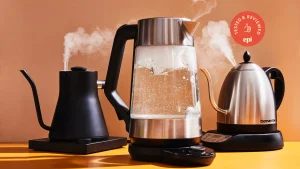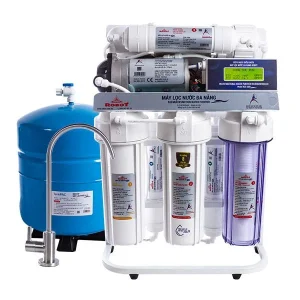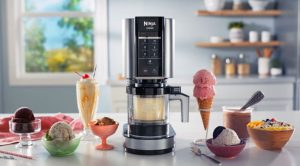Microwave Oven: What Is It? How It Works, Applications, and Safe Usage Tips

A microwave oven is an essential kitchen appliance that uses electromagnetic waves to cook or heat food quickly and efficiently. Unlike conventional ovens, microwave ovens are designed to heat food using microwave radiation, making them a popular choice in many homes and businesses. In this article, we’ll explore what a microwave oven is, how it works, its applications, and provide important safety tips for its usage.
1. What Is a Microwave Oven?
A microwave oven is a kitchen appliance that uses microwave radiation to heat food. The microwave radiation emitted by the oven excites water molecules in food, causing them to vibrate and generate heat, which in turn cooks or warms the food. Microwave ovens are widely used for reheating leftovers, cooking frozen meals, and even preparing a variety of dishes.
Common Types of Microwave Ovens:
- Countertop Microwave Ovens: These are standalone units that can be placed on kitchen counters. They are the most common type, available in various sizes and power levels.
- Over-the-Range Microwave Ovens: These are built into the kitchen cabinetry above the stove, combining both microwave and ventilation functions. They save counter space and offer convenience in smaller kitchens.
- Built-In Microwave Ovens: These units are integrated directly into the kitchen cabinetry, providing a sleek and modern look while saving space.
- Microwave Convection Ovens: These combine the functions of a traditional microwave oven and a convection oven, allowing for baking and roasting in addition to microwaving.
Benefits of Microwave Ovens:
- Quick Cooking: Microwaves heat food much faster than conventional ovens, making them ideal for busy lifestyles.
- Energy Efficiency: Microwave ovens use less energy compared to traditional ovens because they heat only the food, not the air around it.
- Convenience: With a microwave, you can reheat food, defrost frozen items, and cook meals with ease. They are user-friendly and require minimal preparation.
2. How Does a Microwave Oven Work?
A microwave oven works by using electromagnetic waves known as microwaves to generate heat inside food. These waves are a form of non-ionizing radiation, meaning they do not change the molecular structure of food, making them safe for cooking. Here’s a closer look at the components and how they work together:
Key Components of a Microwave Oven:
- Magnetron: The magnetron is the component that generates the microwaves. It converts electrical energy into microwave radiation.
- Microwave Chamber: This is the part of the oven where food is placed. It’s designed to reflect microwaves evenly around the food to ensure uniform cooking.
- Turntable: Many microwave ovens are equipped with a rotating turntable that ensures the food is heated evenly by rotating it during cooking.
- Control Panel: The control panel allows you to adjust settings such as time, power level, and cooking mode. Some microwave ovens come with preset cooking functions for convenience.
- Door and Safety Mechanisms: The microwave oven door is equipped with a metal mesh to keep the microwaves contained inside. Safety mechanisms ensure that the microwave doesn’t operate when the door is open.
The Cooking Process:
- Microwave Radiation: When you start the microwave oven, the magnetron produces microwaves that are directed into the cooking chamber.
- Exciting Water Molecules: These microwaves are absorbed by food, particularly water molecules, causing them to vibrate. The friction between the molecules generates heat, which cooks or warms the food.
- Even Heating: The turntable or rotating tray ensures that the food moves and allows the microwaves to penetrate evenly, preventing hot spots and undercooking.
3. Applications of Microwave Ovens
Microwave ovens are versatile and can be used in a variety of settings. Here are some of the most common applications:
Residential Use:
- Reheating Leftovers: One of the most common uses for a microwave is reheating food, such as leftovers from dinner or snacks.
- Defrosting Frozen Food: Microwaves are perfect for defrosting frozen foods like meat, vegetables, and prepared meals quickly.
- Cooking Convenient Meals: Many people use microwaves to cook ready-to-eat meals, including frozen dinners, microwaveable popcorn, and instant noodles.
- Baking and Cooking: Some microwave ovens, especially convection models, can bake cakes, roast meats, and cook other dishes that traditionally require an oven.
Commercial Use:
- Restaurants and Cafes: Microwave ovens are widely used in commercial kitchens to quickly heat food or prepare certain types of meals, such as heating up sauces or defrosting frozen ingredients.
- Catering Services: In catering services, microwaves help in quickly reheating large quantities of food while maintaining taste and texture.
- Offices: Many offices are equipped with microwave ovens, allowing employees to heat up their meals or snacks during lunch breaks.
4. How to Use a Microwave Oven Safely
While microwave ovens are generally safe to use, it’s essential to follow safety guidelines to prevent accidents and ensure proper functionality. Here are some important tips for safe use:
Installation and Setup:
- Proper Placement: Place the microwave oven on a flat, stable surface, away from any heat sources or moisture. Ensure there is enough space around the oven for proper ventilation.
- Electrical Safety: Always plug the microwave oven directly into a wall outlet. Avoid using extension cords or overloading electrical circuits, as this can cause overheating or fires.
Cooking Tips:
- Use Microwave-Safe Containers: Only use containers that are labeled microwave-safe. Avoid using metal, aluminum foil, or containers with metallic trim, as they can cause sparks or fires.
- Stir Food Occasionally: If you’re reheating or cooking large portions, stir the food halfway through the cooking process to ensure even heating.
- Cover Food: When heating food, use microwave-safe lids or microwave-safe plastic wraps to cover the food. This helps to keep moisture in and prevents splattering.
- Be Careful with Hot Food: Microwaved food can get extremely hot, especially liquids. Always use caution when removing food from the microwave, and use oven mitts if necessary.
Regular Maintenance:
- Clean the Microwave: Regularly clean the interior of the microwave to prevent the buildup of food splatters and odors. Use a damp cloth or sponge to wipe the surfaces.
- Check the Door Seal: Make sure the microwave door closes properly and the seal is intact. A broken seal can lead to microwave leakage, which may be harmful.
- Avoid Overheating: Never run the microwave empty or for extended periods without food. This can damage the microwave’s components and lead to overheating.
Safety Precautions:
- Don’t Overheat Liquids: When heating liquids, be aware of the risk of superheating, where liquid may boil explosively once disturbed. Stir liquids before heating and let them cool slightly before handling.
- Supervise Children: Always supervise children when they are using or around a microwave oven. Teach them how to use it safely and avoid touching the hot surfaces.
Conclusion
The microwave oven is an essential kitchen appliance that offers convenience, speed, and energy efficiency. It works by using microwave radiation to heat food quickly and evenly. Whether you are reheating leftovers, cooking meals, or defrosting frozen items, a microwave oven can simplify the cooking process. By following safety guidelines, such as using microwave-safe containers, cleaning regularly, and monitoring the cooking process, you can ensure a safe and effective cooking experience.
With the increasing demand for time-saving and energy-efficient appliances, the microwave oven continues to be a staple in kitchens worldwide, offering practicality and versatility in both home and commercial environments.







